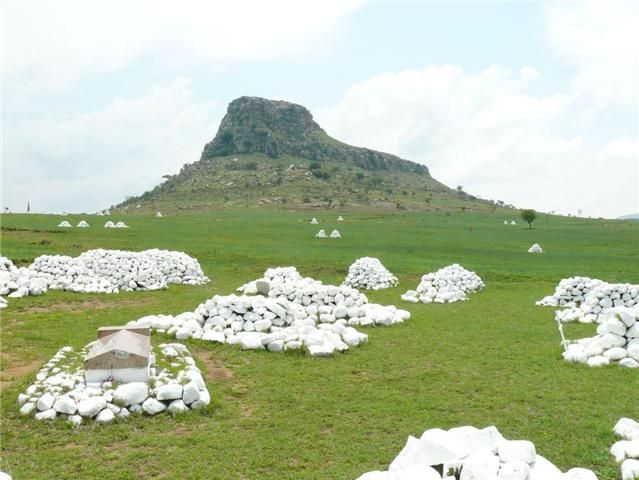As in many parts of the world, the later part of the 19th Century was a time of conflict and confrontation in South Africa, particularly the area we now call KwaZulu-Natal. The British were at the height of their empire-building zeal, the Zulu nation was one of the most powerful in Africa, and the Boers had shaken the dust of British colonialism off their velskoens, and set off into the interior to take control of their own destiny.
Well, that sounds like a recipe for disaster. And it was - for everyone concerned. A real free-for-all scrap, there were skirmishes, stand-up battles, sieges and ambushes. No one - Boer, Brit or Zulu - came away unscathed. The stories are fascinating, and the KZN battlefields are remarkably well preserved. It's not just a raa-raa recreation of sabre-rattling macho imperialism, and it's certainly not a celebration of all things bellicose.
Guided tours offer you the opportunity to stand on the very spot where history was made and hear of how decisions (good and bad) were taken; hear of heroism and heartache, of victory and defeat and of death and destruction. It's definitely food for thought - and it leaves almost everyone pondering on the futility of war.
For the historically inclined, these battles include Voortrekker-Zulu war (1836-1852), the Anglo-Zulu War (1879), two Anglo-Boer wars, one in 1881, and the big one, otherwise known as the South African war (1899-1902), and the Bambata Rebellion (1906). An interesting thing about these battlefields is that some of the biggest players on the planet chose to spend time there.
You can't help but wonder how different world history would have been if the young Winston Churchill or the equally young, zealous and idealistic Mahatma Gandhi had succumbed during these battles.
Or if Prince Louis Napoleon, the last of the Bonaparte line, had survived his little altercation with a small band of Zulu warriors and had gone on to meet some lovely young lady and perpetuate the dynasty.
You can visit the Ultimatum Tree, near Tugela Mouth, where the British pulled a fast one on the Zulu chief Cetswayo, or Gingindlovu, where the Zulus were more than a little surprised to be the first people in the world to feel the force of the Gatling gun (precursor to the now ubiquitous AK 47s, Uzis and other automatic weapons), or mGungundlovu, where the Zulu chief, Dingaan, feeling somewhat threatened by the Boer's obvious land-lust, did away with the Voortrekker Piet Retief and his followers in a rather grisly way.
This was followed by a raid on the Boer encampment at Bloukrans, where the Zulus pretty well trashed the Boers. Oh - human history -
and then the Boers sent a punitive expedition after the Zulus and, after making a deal with god (I kid you not) trashed the Zulus at the rather ironically named Ncome River (which means peace). It was consequently renamed Blood River, which seems far more appropriate. It's like kindergarten - 'but he hit me first....' We never learn, do we?
Other oft-visited sites include Isandlwana - the site of Britain's most humiliating defeat - and the nearby Rorke's Drift where a handful of resourceful redcoats did what they could to salvage imperial pride (not to mention their own skins), Ladysmith, site of one of the longest sieges (119 days) in the South African War, and Dundee, with its Talana Museum on the site of the Talana Battle.
The area known today as Zululand was, initially ignored by the British when they imperiously annexed what was then referred to as Natal and the Zulus retained sovereignty over all the land north of the Buffalo and Tugela Rivers - for a while, at least. The overlap is quite broad - the battlefields comprises large parts of Zululand and extends as far as Pietermaritzburg, almost to the foot of the Drakensberg, and Zululand covers much of the battlefield territory, while extending further north to St Lucia in the southern part of the Greater St Lucia Wetland Park, where the border between northern Zululand and southern Maputaland is rather hazy. Zululand also includes the fantastic Hluhluwe-Umfolozi Game Reserve, which is the ancestral home of all the white rhinos now living in southern Africa. Seriously - they were extinct everywhere else and were brought back from the brink in this rather lovely park. Imagine - we came a hair's breadth from never, ever seeing a white rhino.
There's loads to do here. A tour of the battlefields is a given - either by vehicle, by foot or on horseback. And it probably won't be long before someone offers cycle tours. There are some great river trips, with the Tugela and Buffalo Rivers throwing up some challenging white water. Wilderness walks in Hluhluwe-Umfolozi are a truly awesome adventure - it's a real wilderness experience in Big Five country. If you want to see the picture-book Zulus, there are a handful of cultural villages that offer dancing, an insight into traditional crafts and some historical and cultural insights. And, of course, there are the beaches - all long and lovely.
View our newsletter article Durban Now for more about the Ncome Blood River Heritage site and festivals.
Battlefields Fun Rating
from 154 customer reviewsPopular in Battlefields
-
Battlefields
-
-
Restaurants
-
Nature Reserve
-
History Tours




